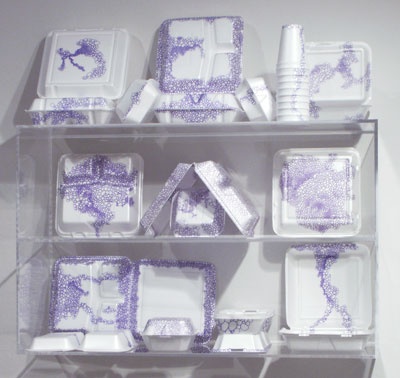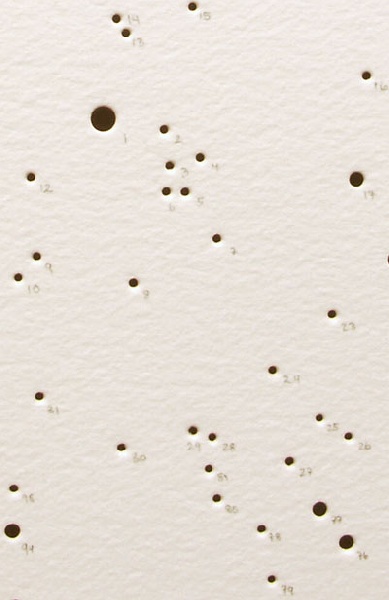Rachel Perry Welty at Barbara Krakow Gallery
Consumerism in Miniature
By: Shawn Hill - Feb 24, 2008
Rachel Perry Welty
Same Difference
thru February 27, 2008
Barbara Krakow Gallery
www.barbarakrakowgallery.com
Rachel Perry Welty is an economist. Not just in the way that her minimal aesthetic comprises the frugal use of limited materials. But also in the sense of keeping an eye on the exchange rate. Welty's currency is largely domestic, much of it food-oriented. Styrofoam take out boxes, aluminum foil, boxes of Brillo pads and the labels used to brand fruits and vegetables are her basic units of construction.
These are pretty meager materials, yet her works fill the Krakow Gallery with the size of their ideas. Her accumulations of forms are neat and organized, orderly like a kitchen maintained by a fastidious housewife. Her wares are just odder than most.
The stacks of Styrofoam trays, perfectly clean and unused, have been augmented with ballpoint pen loops. These cellular forms grow and spread across the plastic surfaces. Are they bacterial infections, made visible? Are they the decay matrix of the Styrofoam, perhaps a new environmentally-conscious version meant to disappear some centuries after use?
Likely not the latter, as her suggestive and brief gallery notes (available at the desk) describe her work as a reaction against "an increasingly shrill need for a 'greener' world."
Still, that economy serves its purpose. Two legends in the gallery "Shopping Experience: Did you find everything you were looking for?" and "Spam Series: Lucky Day" are made of single pieces of aluminum foil, shaped into elegant cursive script. Welty's spare works are a counterpoint to the consumerist society they critique: almost all of them could have been made from items purchased at Target, but can even that accessible department store answer every human need, no matter how many times you go back?
Another concern involves issues of scale. Those ballpoint pen cells are duplicated on the macrocosmic level by the wall drawings which Welty makes out of carefully recut fruit stickers. She unspools them with her blade, obscuring the corporate insignia but retaining the familiar colors, and repetitive spherical shapes they enclose which still hints at abundance.
The work that seems most free from commercial concerns is defined by an obsessive need to count. "Constellation" consists of a random, vaguely spiral pattern of perfectly circular holes cut into a large sheet of paper. Each of these pin pricks is numbered in pencil. The process is evident: each puncture was first made and then recorded by the artist. The count starts at the center at "1" but out on the edges of this inverted star field I stopped trying to find anything higher than "11,441" or so. I wasn't willing to duplicate the artist's effort and perfectly enact the process the work required. But, then, I bet my kitchen isn't as clean as her's.



